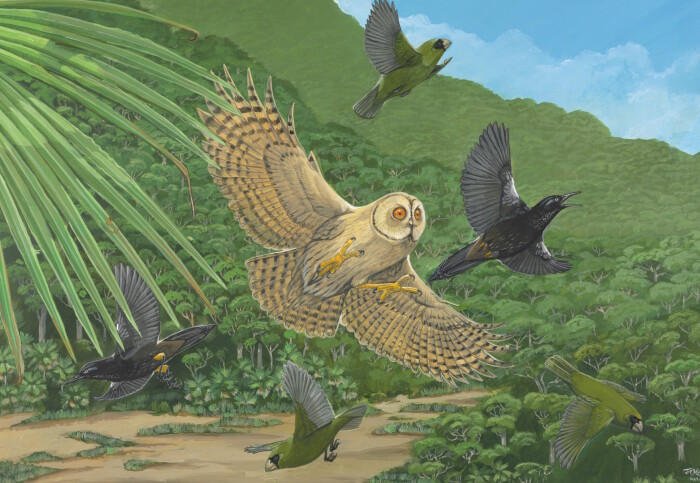True global impact of human-driven bird extinctions far greater than expected

The ongoing loss of bird species is likely to have severe knock-on effects as their unique roles in ecosystems are not fulfilled, shows a new study.
The extinction of hundreds of bird species caused by humans over the last 130,000 years has led to substantial reductions in avian functional diversity – a measure of the range of different roles and functions that birds undertake in the environment – according to a new study published today in Science.
Building a clearer picture of the impacts of these extinctions on ecosystem function is particularly vital given that many more animal species are predicted to disappear over the next century. Professor Joseph Tobias
The research, led by the University of Birmingham and Imperial College London, found these extinctions resulted in the loss of billions of years of evolutionary history, highlighting the consequences of the ongoing biodiversity crisis and the urgent need to identify the ecological functions of species being lost through extinction.
Lead author Dr Tom Matthews, from the University of Birmingham, explained: “The sheer number of bird species that have become extinct is of course a big part of the extinction crisis, but what we also need to focus on is that every species has a job or function within the environment and therefore plays a really important role in its ecosystem.
“Some birds control pests by eating insects, scavenger birds recycle dead matter, others eat fruit and disperse the seeds enabling more plants and trees to grow, and some, like hummingbirds, are very important pollinators. When those species die out, the important role that they play – the functional diversity – dies with them.
Joint senior author Professor Joseph Tobias, from the Department of Life Sciences at Imperial, added: “In most cases, of course, we don’t know much about the ecology of extinct species, but we can estimate their ecological roles from preserved specimens or fossilized skeletons. We did this by measuring the beaks and bones of extinct birds and comparing them to existing measurements taken from living birds with known behaviours.”
An era of extinction
From the infamous Dodo to the Alagoas Foliage-gleaner last seen in 2012, scientists are aware of around 610 bird extinctions since the Late Pleistocene, 130,000 years ago, when modern humans started to spread throughout the world.

More than 90% of these extinctions were caused at least partly by humans. By grafting these human-caused extinctions onto a tree of all living bird species, the study showed that humans have contributed to the loss of approximately three billion years of unique evolutionary history.
Dr Matthews said: “In addition to functional diversity each species also carries a certain amount of evolutionary history; therefore when that species becomes extinct, it’s basically like chopping off a branch of the tree of life and all of that associated phylogenetic diversity is also lost.”
By compiling the most comprehensive dataset to date of all known bird extinctions during the Late Pleistocene and Holocene (the current era, starting around 12,000 years ago), and gathering morphological measurements from as many of these extinct species as possible, the authors found that human-caused bird extinctions have resulted in a loss of 7% of global avian functional diversity over this period – a significantly larger amount than expected based on the number of extinctions.
Ecological impacts and long-term solutions
Given the wide range of vital roles performed by birds, this loss of ecological diversity has serious implications. Examples of post-extinction aftershocks include reduced flower pollination, reduced seed dispersal, the breakdown of top-down control of insect populations – including many pests and disease carriers – as well as increased disease outbreaks due to reduced consumption of carrion.
Professor Tobias concludes: “Our study provides a timely reminder that the current extinction crisis is not just about species numbers. Many of the birds driven extinct directly or indirectly by humans were highly distinctive and ecologically important. Building a clearer picture of the impacts of these extinctions on ecosystem function is particularly vital given that many more animal species are predicted to disappear over the next century.
“Ultimately, improved knowledge about the types of species driven to extinction in the past can help us to safeguard remaining biodiversity for the future, for example through targeted conservation actions, including restoration and rewilding programmes.
---
‘The global loss of avian functional and phylogenetic diversity from anthropogenic extinctions’ by Thomas J. Matthews, Kostas A. Triantis, Joseph P. Wayman, Thomas E. Martin, Julian P. Hume, Pedro Cardoso, Søren Faurby, Chase D. Mendenhall, Paul Dufour, François Rigal, Rob Cooke, Robert J. Whittaker, Alex L. Pigot, Christophe Thébaud, Maria Wagner Jørgensen, Eva Benavides, Filipa C. Soares, Werner Ulrich, Yasuhiro Kubota, Jon P. Sadler, Joseph. A. Tobias, and Ferran Sayol is published in Science.
Adapted from a press release by the University of Birmingham.
Article text (excluding photos or graphics) © Imperial College London.
Photos and graphics subject to third party copyright used with permission or © Imperial College London.
Reporter
Hayley Dunning
Communications Division